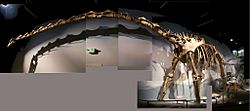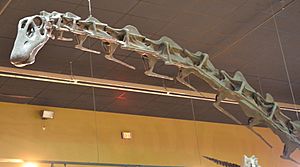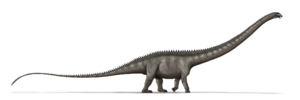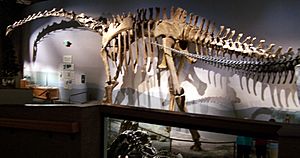Supersaurus facts for kids
Quick facts for kids SupersaurusTemporal range: Upper Jurassic
|
|
|---|---|
 |
|
| Scientific classification | |
| Kingdom: | |
| Class: | |
| Superorder: | |
| Order: | |
| Suborder: | |
| Infraorder: | |
| Family: | |
| Genus: |
Supersaurus
|
Supersaurus was a giant plant-eating dinosaur. It belonged to a group called sauropods, which includes other long-necked dinosaurs like Diplodocus. Scientists found its bones in Colorado in 1972. These fossils came from rocks formed during the Upper Jurassic period.
Supersaurus was one of the longest dinosaurs ever known. It could grow up to 33 to 34 meters (108 to 112 feet) long. That's about as long as three school buses! It weighed around 35 to 40 tons, which is like seven adult elephants.
A more complete skeleton of Supersaurus was found in Wyoming in 1996. This fossil was nicknamed 'Jimbo'. It helped scientists learn even more about this amazing dinosaur.
What Did Supersaurus Look Like?
Supersaurus was one of the largest dinosaurs. It had a very long neck, even for a sauropod. Its neck bones, called cervical vertebrae, were super long. This made its neck one of the longest of any known dinosaur.
Scientists think Supersaurus looked a bit like Apatosaurus. However, Supersaurus was built a little lighter. Its body was not as thick or heavy as Apatosaurus. The first bones found were very large. They showed it was a huge member of the diplodocid family.
One neck bone found was 1380 millimeters (about 54 inches) long. This is the longest neck bone ever found from a dinosaur! The 'Jimbo' skeleton helped confirm these ideas. It showed Supersaurus had a very long, slender neck.
How Was Supersaurus Discovered?
The first Supersaurus bones were found in 1972. They were discovered in a place called the Dry Mesa Quarry. This quarry is in Colorado. At first, only a few bones were found. These included parts of its shoulder, hip, and tail.
Paleontologist James A. Jensen studied these bones. He named the dinosaur Supersaurus in 1985. One of the main bones was a shoulder blade. It was about 2.4 meters (8 feet) tall if stood upright! People started calling it "Supersaurus" informally even earlier, in 1973.
Some scientists thought the bones might belong to a very large Barosaurus. But later studies showed that Supersaurus was its own unique dinosaur.

In 1986, a much more complete skeleton was found. Two hikers, Brandon Flyr and Bart Lesco, found it in Converse County, Wyoming. This skeleton was later nicknamed "Jimbo" in 1996. Scientists officially described it in 2007.
The 'Jimbo' skeleton included about 30% of the dinosaur's bones. These bones are now kept at the Wyoming Dinosaur Center. Studying 'Jimbo' helped scientists figure out which other bones found earlier also belonged to Supersaurus.
Supersaurus lived during the Tithonian age. This was the very end of the Jurassic period.
Images for kids
-
Dorsal vertebra BYU 9044, now assigned to Supersaurus, at the Museum of Ancient Life.
-
Pelvis BYU 130185, currently assigned to Supersaurus, at the Museum of Ancient Life.
See also
 In Spanish: Supersaurus para niños
In Spanish: Supersaurus para niños








